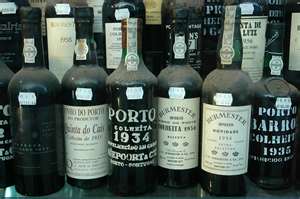Port is a Portuguese fortified wine produced exclusively in the Douro Valley in the northern provinces of Portugal. Other countries produce similar wines but only those from Portugal may be labeled as “port” or “Porto.”
Grapes grown in the Douro Valley have small dense fruit which produce concentrated and long-lasting flavors. Regulations of Portugal’s Instituto dos Vinhos Douro e Porto allow use of more than 100 grape varieties for port but only the few most desirable are grown in abundance. Grapes are first fermented into red or white wine, then distilled grape spirits are added to stop fermentation before sugar is completely converted to alcohol. This fortification process yields a sweeter, richer, and heavier wine with an alcohol content of 18%-20%.
Some of these wines are aged exclusively in wooden barrels. Known as “oxidative” aging, this gives the wine a small exposure to oxygen which adds a nutty fragrance. The product slowly loses color and evaporates yielding a wine that is slightly more viscous. A port described simply as tawny has been aged in barrels at least two years. A tawny port further described with an age category of 10, 20, 30, or more than 40 years indicates a blend of several vintages aged not those exact numbers of years, but aged to produce a target taste profile. Tawny port from a single vintage is called Colheita. The actual vintage year is given on the label instead of the age profile. Tawny ports are golden brown in color, are sweet or medium dry, and are used as a dessert wine.
BOTTLE-AGED PORTS
Unlike alcoholic products made from cereal grains, wine continues to age in the bottle. Port wines that mature in sealed glass bottles with no exposure to air go through “reductive” aging. Stored in relative darkness, they lose color more slowly and gradually become smooth and less acidic. Some are filtered before bottling and are thus ready to drink when the proper age and taste is achieved. Others are not filtered and must be decanted before drinking and consumed within a few days. Many believe filtration strips away much of the port’s character so do not consider this an inconvenience.
Ruby port is the cheapest and most widely produced. It is stored in concrete or stainless steel tanks after fortification to prevent oxidation and to preserve its color. It is blended to match a particular taste profile and does not usually improve with age. Rose port is similar to ruby but fermented with limited exposure to grape skins, thus creating the lighter color. White port is made from white grapes and its taste ranges from dry to very sweet. At a young age it is best used for cocktails. White ports of greater age are best served chilled on their own.
Crusted port is a blend of port wine from several vintages and is required to be bottle-aged at least three years before being marketed. Most producers wait much longer, however, so the port can be consumed immediately rather than having to age many years in the purchaser’s cellar.
Vintage port is made entirely from grapes of a declared “vintage year.” Each producer decides whether to declare a year’s harvest “vintage” and does so about three times a decade. Vintage ports are aged up to two and a half years in barrels, then another ten to forty years in bottles to achieve the desired taste. Though it is the most highly regarded type, vintage port accounts for only a small percentage of production. Fine vintage ports continue to gain complexity through the years and are still excellent many decades after they were bottled.
_______________
“Port is not for the very young, the vain and the active. It is the comfort of age and the companion of the scholar and the philosopher.” — Evelyn Waugh
_______________
Source: Port wine article in Wikepedia.

